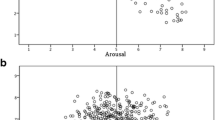Abstract
The field of human–drone interaction (HDI) has investigated an increasing number of applications for social drones, all while focusing on the drone’s inherent ability to fly, thus overpassing interaction opportunities, such as a drone in its perched (i.e., non-flying) state. A drone cannot constantly fly and a need for more realistic HDI is needed, therefore, in this exploratory work, we have decoupled a social drone’s flying state from its perched state and investigated user interpretations of its physical rendering. To do so, we designed and developed BiRDe: a Bodily expressIons and Respiration Drone conveying Emotions. BiRDe was designed to render a range of emotional states by modulating its respiratory rate (RR) and changing its body posture using reconfigurable wings and head positions. Following its design, a validation study was conducted. In a laboratory study, participants (\({N}={30}\)) observed and labeled twelve of BiRDe’s emotional behaviors using Valence and Arousal based emotional states. We identified consistent patterns in how BiRDe’s RR, wings, and head had influenced perception in terms of valence, arousal, and willingness to interact. Furthermore, participants interpreted 11 out of the 12 behaviors in line with our initial design intentions. This work demonstrates a drone’s ability to communicate emotions even while perched and offers design implications and future applications.










Similar content being viewed by others
Data Availability
The data that support the findings of this study are available upon reasonable request from the corresponding author [OF]. The data are not publicly available due to ethical restrictions.
References
Herdel V, Yamin LJ, Cauchard JR (2022) Above and beyond: a scoping review of domains and applications for human–drone interaction. In: Proceedings of the 2022 CHI conference on human factors in computing systems. Association for Computing Machinery, New York, NY, USA, CHI ’22. https://doi.org/10.1145/3491102.3501881,
Obaid M, Johal W, Mubin O (2020) Domestic drones: context of use in research literature. In: Proceedings of the 8th international conference on human-agent interaction. association for computing machinery, New York, NY, USA, HAI ’20, pp 196–203. https://doi.org/10.1145/3406499.3415076,
Yohanan S, MacLean KE (2012) The role of affective touch in human–robot interaction: human intent and expectations in touching the haptic creature. Int J Soc Robot 4(2):163–180
Wojciechowska A, Frey J, Mandelblum E et al (2019) Designing drones: Factors and characteristics influencing the perception of flying robots. In: Proceedings of ACM interactive, mobile, wearable and ubiquitous technologies 3(3). https://doi.org/10.1145/3351269,
Cauchard JR, E. JL, Zhai KY et al (2015) Drone & me: an exploration into natural human-drone interaction. In: Proceedings of the 2015 ACM international joint conference on pervasive and ubiquitous computing—UbiComp ’15. Association for Computing Machinery, New York, New York, USA, pp 361–365, https://doi.org/10.1145/2750858.2805823,
Shapira S, Cauchard JR (2022) Integrating drones in response to public health emergencies: a combined framework to explore technology acceptance. Front Public Health 10(1019):626. https://doi.org/10.3389/fpubh.2022.1019626
Zhang M, Gursoy D, Zhu Z et al (2021) Impact of anthropomorphic features of artificially intelligent service robots on consumer acceptance: moderating role of sense of humor. Int J Contemp Hosp Manag 33(11):3883–3905. https://doi.org/10.1108/IJCHM-11-2020-1256
Stock-Homburg R (2022) Survey of emotions in human–robot interactions: perspectives from robotic psychology on 20 years of research. Int J Soc Robot 14(2):389–411. https://doi.org/10.1007/s12369-021-00778-6
La Delfa J, Baytas MA, Wichtowski O, et al (2019) Are drones meditative? In: Extended abstracts of the 2019 CHI conference on human factors in computing systems. Association for Computing Machinery, New York, NY, USA, CHI EA ’19, pp 1–4. https://doi.org/10.1145/3290607.3313274,
Sharma M, Hildebrandt D, Newman G et al (2013) Communicating affect via flight path exploring use of the Laban effort system for designing affective locomotion paths. In: 2013 8th ACM/IEEE international conference on human–robot interaction (HRI). IEEE, Tokyo, Japan, pp 293–300. https://doi.org/10.1109/HRI.2013.6483602
Cauchard JR, Zhai KY, Spadafora M et al (2016) Emotion encoding in human-drone interaction. In: 2016 11th ACM/IEEE international conference on human–robot interaction (HRI). IEEE, Christchurch, New Zealand, pp 263–270. https://doi.org/10.1109/HRI.2016.7451761
Arroyo D, Lucho C, Roncal SJ et al (2014) Daedalus: a sUAV for human–robot interaction. In: Proceedings of the 2014 ACM/IEEE international conference on human–robot interaction. Association for Computing Machinery, New York, NY, USA, HRI ’14, pp 116–117. https://doi.org/10.1145/2559636.2563709,
Jiang H, Lin S, Prabakaran V et al (2019) A survey of users’ expectations towards on-body companion robots. In: Proceedings of the 2019 on designing interactive systems conference. Association for Computing Machinery, New York, NY, USA, DIS ’19, pp 621–632. https://doi.org/10.1145/3322276.3322316,
Bucci P, Cang XL, Valair A et al (2017) Sketching cuddlebits: coupled prototyping of body and behaviour for an affective robot pet. In: Proceedings of the 2017 CHI conference on human factors in computing systems. Association for Computing Machinery, New York, NY, USA, CHI ’17, p 3681-3692, https://doi.org/10.1145/3025453.3025774,
Watson D, Clark LA, Tellegen A (1988) Development and validation of brief measures of positive and negative affect: the PANAS scales. J Pers Soc Psychol 6(54):1063–1070. https://doi.org/10.1037/0022-3514.54.6.1063
La Delfa J, Baytas MA, Patibanda R et al (2020) Drone chi: somaesthetic human–drone interaction. In: Proceedings of the 2020 CHI conference on human factors in computing systems. Association for Computing Machinery, New York, NY, USA, CHI ’20, pp 1–13. https://doi.org/10.1145/3313831.3376786,
Auda J, Weigel M, Cauchard JR et al (2021) Understanding drone landing on the human body. In: MobileHCI 2021: ACM international conference on mobile human–computer interaction. Association for Computing Machinery, pp 1–19 (to appear). https://doi.org/10.1145/3447526.3472031
Baytas MA, Çay D, Zhang Y et al (2019) The design of social drones: a review of studies on autonomous flyers in inhabited environments. Association for Computing Machinery, New York, NY, USA, pp 1–13. https://doi.org/10.1145/3290605.3300480
Cauchard JR, Gover W, Chen W et al (2021) Drones in wonderland—disentangling collocated interaction using radical form. IEEE Robot Autom Lett. https://doi.org/10.1109/LRA.2021.3103653
Kim HY, Kim B, Kim J (2016) The naughty drone: a qualitative research on drone as companion device. In: Proceedings of the 10th international conference on ubiquitous information management and communication. Association for Computing Machinery, New York, NY, USA, IMCOM ’16. https://doi.org/10.1145/2857546.2857639,
Herdel V, Kuzminykh A, Hildebrandt A et al (2021) Drone in love: emotional perception of facial expressions on flying robots. In: Proceedings of the 2021 CHI conference on human factors in computing systems. Association for Computing Machinery, New York, NY, USA, CHI ’21. https://doi.org/10.1145/3411764.3445495,
Bynion TM, Feldner MT (2020) Self-assessment manikin, pp 4654–4656. https://doi.org/10.1007/978-3-319-28099-8_77-1
Law T, de Leeuw J, Long JH (2021) How movements of a non-humanoid robot affect emotional perceptions and trust. Int J Soc Robot 13(8):1967–1978. https://doi.org/10.1007/s12369-020-00711-3
Laban G, Le Maguer S, Lee M et al (2022) Robo-identity: exploring artificial identity and emotion via speech interactions. In: 2022 17th ACM/IEEE international conference on human–robot interaction (HRI), pp 1265–1268. https://doi.org/10.1109/HRI53351.2022.9889649
Lin A, Scheller M, Feng F et al (2021) Feeling colours: crossmodal correspondences between tangible 3D objects, colours and emotions. In: Proceedings of the 2021 CHI conference on human factors in computing systems. Association for Computing Machinery, New York, NY, USA, CHI ’21. https://doi.org/10.1145/3411764.3445373
Blue Frog Robotics (2021) Buddy the emotional robot. https://buddytherobot.com/en/buddy-the-emotional-robot/. Accessed 31 August 2021
Bucci P, Zhang L, Cang XL et al (2018) Is it happy? behavioural and narrative frame complexity impact perceptions of a simple furry robot’s emotions. In: Proceedings of the 2018 CHI conference on human factors in computing systems. Association for Computing Machinery, New York, NY, USA, CHI ’18, pp 1–11. https://doi.org/10.1145/3173574.3174083,
Barrett LF, Russell JA (1998) Independence and bipolarity in the structure of current affect. J Pers Soc Psychol 74(4):967–984. https://doi.org/10.1037/0022-3514.74.4.967
Yik M, Mues C, Sze IN et al (2022) On the relationship between valence and arousal in samples across the globe. Emotion. https://doi.org/10.1037/emo0001095
Klausen TA, Farhadi U, Vlachos E et al (2022) Signalling emotions with a breathing soft robot. In: 2022 IEEE 5th international conference on soft robotics (RoboSoft), pp 194–200. https://doi.org/10.1109/RoboSoft54090.2022.9762140
Beri D, Reddy J (2019) Physiological correlates of arousal: a metaanalytic review. J Neurol Neurosci 10(4)
Frey J, Grabli M, Slyper R et al (2018) Breeze: sharing biofeedback through wearable technologies. In: Proceedings of the 2018 CHI conference on human factors in computing systems. Association for Computing Machinery, New York, NY, USA, CHI ’18, pp 1–12. https://doi.org/10.1145/3173574.3174219
Tsiourti C, Weiss A, Wac K et al (2019) Multimodal integration of emotional signals from voice, body, and context: effects of (in)congruence on emotion recognition and attitudes towards robots. Int J Soc Robot 11(4):555–573. https://doi.org/10.1007/s12369-019-00524-z
Marmpena M, Lim A, Dahl TS et al (2019) Generating robotic emotional body language with variational autoencoders. In: 2019 8th international conference on affective computing and intelligent interaction (ACII), pp 545–551. https://doi.org/10.1109/ACII.2019.8925459
Karjalainen KD, Romell AES, Ratsamee P et al (2017) Social drone companion for the home environment: a user-centric exploration. In: Proceedings of the 5th international conference on human agent interaction. Association for Computing Machinery, New York, NY, USA, HAI ’17, pp 89–96. https://doi.org/10.1145/3125739.3125774,
Yeh A, Ratsamee P, Kiyokawa K et al (2017) Exploring proxemics for human-drone interaction. In: Proceedings of the 5th international conference on human agent interaction. Association for Computing Machinery, New York, NY, USA, HAI ’17, pp 81–88. https://doi.org/10.1145/3125739.3125773,
Nomura T, Suzuki T, Kanda T et al (2006) Measurement of negative attitudes toward robots. Interact Stud 7(3):437–454. https://doi.org/10.1075/is.7.3.14nom
Pometko A, Dagan E, Altarriba Bertran F et al (2021) Drawing from social media to inspire increasingly playful and social drone futures. In: Designing interactive systems conference 2021. Association for Computing Machinery, New York, NY, USA, DIS ’21, pp 697–706. https://doi.org/10.1145/3461778.3462020,
Deng H, Li J, Sayegh A et al (2018) Twinkle: a flying lighting companion for urban safety. In: Proceedings of the twelfth international conference on tangible, embedded, and embodied interaction. Association for Computing Machinery, New York, NY, USA, TEI ’18, pp 567–573. https://doi.org/10.1145/3173225.3173309,
Berdasco A, López G, Diaz I et al (2019) User experience comparison of intelligent personal assistants: Alexa, Google assistant, Siri and Cortana. In: Proceedings of the 13th international conference on ubiquitous computing and ambient intelligence. MDPI, no. 31 in 51, p 8. https://doi.org/10.3390/proceedings2019031051,
Acknowledgements
This research was partially supported by Ben-Gurion University of the Negev through the Agricultural, Biological, and Cognitive Robotics Initiative and the Marcus Endowment Fund.
Funding
Partial financial support was received from the Helmsley Charitable Trust through the Agricultural, Biological and Cognitive Robotics Initiative, and by the Marcus Endowment Fund (both at Ben-Gurion University of the Negev), and by the Mitacs Globalink Research Award (Grant No. IT29828), and the Israel Science Foundation (ISF) (Grant No. 2521/22).
Author information
Authors and Affiliations
Contributions
All authors contributed to the study conception and design. Material preparation and data collection were performed by Ori Fartook and analysis by Ori Fartook and Tal Oron-Gilad. The first draft of the manuscript was written by Ori Fartook and all authors commented on previous versions of the manuscript. All authors read and approved the final manuscript.
Corresponding author
Ethics declarations
Conflict of interest
The authors have no relevant financial or non-financial interests to disclose.
Ethics Approval
The questionnaires and methodology for this study were approved by the Human Research Ethics Committee of Ben-Gurion University of the Negev.
Consent to Participate
Informed consent was obtained from all individual participants included in the study.
Consent for Publication
Patients signed informed consent regarding publishing their data.
Additional information
Publisher's Note
Springer Nature remains neutral with regard to jurisdictional claims in published maps and institutional affiliations.
Appendix A: BiRDe’s 12 Behaviors
Appendix A: BiRDe’s 12 Behaviors
Rights and permissions
Springer Nature or its licensor (e.g. a society or other partner) holds exclusive rights to this article under a publishing agreement with the author(s) or other rightsholder(s); author self-archiving of the accepted manuscript version of this article is solely governed by the terms of such publishing agreement and applicable law.
About this article
Cite this article
Fartook, O., MacLean, K., Oron-Gilad, T. et al. Expanding the Interaction Repertoire of a Social Drone: Physically Expressive Possibilities of a Perched BiRDe. Int J of Soc Robotics 16, 257–280 (2024). https://doi.org/10.1007/s12369-023-01079-w
Accepted:
Published:
Issue Date:
DOI: https://doi.org/10.1007/s12369-023-01079-w







